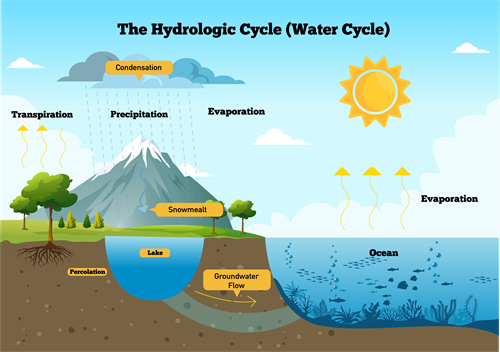PDF chapter test TRY NOW
In order to use water efficiently, we must understand the phenomena behind the availability of water. The study of water availability helps us to optimise the usage of water resources.
Hydrology is the science that encompasses the study of water on the Earth's surface and beneath the surface of the Earth, the occurrence, distribution, and movement of water, the physical and chemical properties of water, and its relationship with the living and material components of the environment.
The hydrological cycle explains the path traced by a water droplet from the time it touches the ground until it evaporates and returns to the atmosphere.
Water is not uniformly distributed throughout the Earth. This gives rise to the difference in availability of water, i.e. some are rich in availability, and some remain scarce in water resources.

The hydrologic cycle is a global phenomenon driven by solar heat, which transports water from the ocean surface to the atmosphere, from the atmosphere to land and from land back to oceans. This cycle of water can be considered as a closed system for the Earth, as the quantity of water involved in the cycle remains the same, though its distribution varies over space and time.
Water evaporates from the surface and transpiration from plants. It gets condensed on condensation nuclei, on reaching higher altitudes and form clouds (resulting in droplet growth).
The clouds melt or burst, resulting in precipitation of different forms. Water that percolates and reaches the groundwater table recharges groundwater. Another portion that flows over the land is called runoff.
The hydrologic cycle is a continuous process of the circulation of water, and it takes place naturally. The three important phases of the hydrologic cycle are:1) Evapotranspiration, 2) Precipitation and 3) Runoff.
